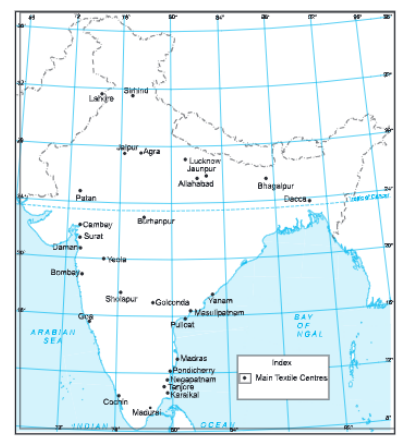KSEEB Solutions for Class 8 History Chapter 7 Weavers, Iron Smelters And Factory Owners Textbook Questions
Question 1. What kinds of cloth had a large market in Europe?
Answer. All finely woven textiles, cotton clothes, printed cotton clothes and silk clothes had a large market in Europe
Question 2. What is Jamdani?
Answer. Jamdani is a fine muslin (woven textile) consisting of decorative motifs woven on the loom with a mixture of cotton and gold thread, usually in grey and white. Dacca in Bengal and Lucknow in the United Provinces were the two major centres for jamdari weaving.
Question 3. What is a bandanna?
Answer. It is a printed scarf produced through a method of tying and dying for head or the neck usually bright in color.
Question 4. Who are the Agarias?
Answer. The Agarias were a community of iron smelters in Central India.
5. Fill in the blanks:
(a) The word chintz comes from the word ______
(b) Tipu’s sword was made of ______steel.
(c) India’s textile exports declined in the _______ century.
Answer. (a) Chhint (b) Wootz (c) Nineteenth
Question 6. How do the names of different textiles tell us about their histories?
Answer
- First of all, the European traders came to know about fine cotton cloth of India which was carried by Arab merchants to Mosul in today’s Iraq. Hence, the term muslin was originated.
- The Portuguese arrived at Calicut in search of spices. They stalled trading in cotton textiles that they carried back with them along with the spices as ‘Calico’, which became the common name.
- Pieces of printed cotton clothes called Chintz, Cossaes and Bandannas were demanded by the Europeans in bulk. The term Chintz was derived from Hindi word Chhint which basically means a cloth having small and colorful flowery designs.
- In the same way, bandanna originated from the word bandhna (Hindi word for tying) which referred to bright-colored clothes produced through the method of tying and dying.
Question 7. Why did the wool and silk producers in England protest against the import of Indian textiles in the early eighteenth century?
Answer. The British wool and silk producers were unable to compete with Indian textiles. As English producers wanted a safe and secure market, they prevented the entry of Indian textiles in England. Therefore’ they protested the import of Indian textiles in the early 18th century.
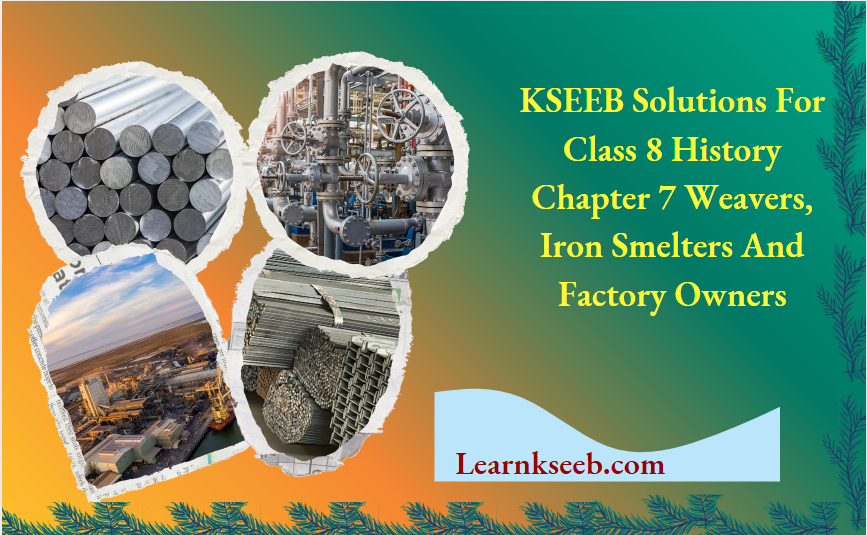
Question 8. How did the development of cotton industries in Britain affect textile producers in India?
Answer
- The industrial revolution came in Europe and Britain itself started producing a lot of textile goods due to w hich export of Indian textiles declined.
- Textile goods made in industries of Britain were very cheap and were of better quality as i compared to Indian textiles. This is another reason for the decline of Indian textiles.
- The European countries imposed heavy taxes on Indian textiles so that they could become
more expensive. Gradually, their sale as well as export declined. In this way, the development of cotton industries in Britain affected the textile producers in India
Question 9. Why did the Indian iron smelting industry decline in the nineteenth century?
Answer
- One of the reasons of decline of Indian icon smelting industry’ in the 19th century was the passing of new forest laws by the British. As colonial government prevented people from entering the reserved forests, they were unable to find wood for charcoal. They were unable to collect wood without defying forest laws. So, many of them gave up their craft and took to other means of livelihood.
- In some areas, the government allowed the people to enter the forests but they had to pay very high tax for every furnace they used. It reduced their income. Moreover, they faced new competition from British manufacturers. Therefore, the Indian iron smelting industry declined in the 19th century.
Class 8 History KSEEB Weavers And Iron Smelters Notes
Question 10. What problems did the Indian textile industry face in the early years of its development?
Answer
- The Indian textile industry faced the following problems in the early years of its development:
- The British started to export its cheap and good-quality textiles to India. The Indian textiles could not compete with cheap imported textiles from Britain.
- Generally, the government supports its industries by imposing heavy duties on imports. It eliminates competition and protects newly-born industries. But, the colonial government in India refused to give such protection to local industries.
Question 11. What helped TISCO to expand steel production during the First World War?
Answer. in its early days, TISCO faced stiff competition from the British steel manufacturers. After the First j World War broke out in 1914, the British steel-producing companies had to meet the demands j of war in Europe. Hence, the import of British steel to India suddenly declined. As a result, Indian j railways looked towards TISCO for its supply of steel. The war continued for five years and TISCO j had to produce carriage wheels and shells for the war. By 1919, 90% of steel manufactured by i TISCO was being bought by the colonial government
Weavers, Iron Smelters and Factory Owners In-Text Questions
Question 1. Why do you think the Act was called the Calico Act? What does the name tell us about the kind of textiles the Act wanted to ban?
Answer A legislation was passed by the British Government in 1720 which banned the use of pointed cotton textiles, i.e., chintz in England. This Act was known as the Calico Act.
Question 2. Where were the major centres of weaving in the late eighteenth century?
Answer In late eighteenth century, the main centres of weaving were Dacca, Tanjore, Pulicat, Ahmedabad, Benares and Sanganer.
Question 3. Read Sources 1 and 2. What reasons do the petition writers give for their condition of starvation?
Answer. In Source, the petition writer is a weaver. He states that the colonial government abolished the arrangs (workshops) and he and his family members have become unemployed. He states that they do not know any other skill apart from weaving and if the Board of Trade stops giving them orders for cloth, they will starve.
In Source 2, the petition writer is a widowed spinner. She wrote that she spun yarn for the weavers and made a living. After the colonial government started importing a new type of yam in Indian markets, the value of the custom-made yam made by her fell. Moreover, the weavers no longer required her yam due to which she has to struggle hard and fight starvation.
Question 4. Why would the iron and steel making industry be affected by the defeat of the nawabs and rajas?
Ans. The iron and steel making industry which marwfactjred the swords and amour of nawabs and rajas declined after the British conquest of India. Moreover, the imports of iron and steel from England took over the market of iron and steel produced by the Indians. Therefore, the iron and steel making industry got severely affected by the defeat of the nawabs and rajas.
Weavers, Iron Smelters and Factory Owners Additional Questions (Solved)
Very Short Answer Type Questions
Question l. Which was the most important port of Indian Ocean trade on west coast of India?
Answer. Surat in Gujarat was the most important port of Indian Ocean trade on the west coast of India.
Question 2. On which two industries did the British focus in India and why?
Answer. The British mainly focussed on textiles as well as iron and steel industry in India since they both were crucial for the industrial revolution in the modem world.
Question 3. When and why did Britain come to be known as the “workshop of the world”?
Answer. Britain became the most powerful industrial nation in the nineteenth century after the mechanised production of cotton textiles. In 1850s, its iron and steel industry began to expand and grow which led to Britain being known as the “workshop of the world”.
KSEEB Class 8 History solutions for Weavers, Iron Smelters and Factory Owners
Question 4. Why were Indian textiles renowned in the world?
Answer. Indian textiles were renowned in the world for their excellent quality and remarkable craftsmanship.
Question 5. What was Muslin?
Answer. The term Muslin referred to all finely woven textiles introduced to European traders by Arab
merchants in Mosul, present-day Iraq.
Question 6. What was Calico?
Answer. The Portuguese came to Calicut in Kerala India in search of spices. Besides spices, they took back cotton textiles to Europe which popularly came to be known as Calico.
Question 7. What was Chintz?
Answer. The term Chintz originated from the Hindi word Chintz which referred to a piece of cloth with small and colorful flowery designs.
Question 8. Why did wool and silk makers of England start protesting against the import of Indian cotton textiles?
Answer. By the early eighteenth century, Indian textiles became very popular in England due to which the demand for British wool arid silk declined. Due to this, the wool arid silk makers of England protested against the import of Indian cotton textiles.
Question 9. How did the East India Company trade in India?
Answer. Initially, the East India Company purchased cotton and silk textiles in India and imported silver. After gaining power in Bengal, they bought Indian goods from the revenue collected by them from its annexed territories.
Question 10. Who were the weavers?
Answer. Weavers generally belonged to the communities that specialised in weaving. Their skills were passed on from one generation to another.
Weavers, Iron Smelters and Factory Owners Short Answer Type Questions
Question 1. How did the industrialisation of Britain have a close connection with the conquest and colonisation of India?
Answer.
- Industrialisation started in Britain after 1760. New factory system was developed and production through machines was started which increased to a great extent
- In the late 18th century, the East India Company made huge profits as they bought goods in India and exported them to England and Europe.
- With the increase in industrial production, the British industrialists sought India as a vast market for selling their industrial goods and purchasing raw materials and therefore, started to conquer Indian colonies. Hence, British industrialisation had a dose connection with the conquest and colonisation of India.
Question 2. What was the position of Indian textiles in the world before the British conquest of India?
Answer.
- Around 1750 India was the largest producer in the world of cotton textiles. Indian textiles
were famous all over the world for their excellent quality and remarkable craftsmanship. - Indian cotton textiles were extensively traded in Southeast Asia as .veil as west and central Asia In the later half of the 15th century’, the European companies started to buy Indian textiles and sold them in Europe making huge profits.
- The excellence of trade and craftsmanship of Indian weavers has been preserved in many current terms of English and other languages.
Question 3. How did the sale of Indian textiles decline?
Answer:
- By 1750 C.E. the cotton industry of England started to develop in Britain which directly affected
the textile producers in India British production increased manifold that flooded the Indian markets. Moreover, by levying several taxes, the import of Indian textiles in Britain was stopped - Indian textiles were forced to compete with British textiles in the European and American markets.
- It became very difficult for Indians to export textiles to England due to high taxes on Indian textiles because of which the sale of Indian textiles declined.
Question 4. Why did not handloom weaving completely die out in India?
Answer.
- Handloom weaving in India did not die completely since machines were not able to produce some types of clothes.
- Machines could not produce sans with intricate bonders or clothes with traditional woven patterns. Such clothes were in great demand in both high as well as middle class societies.
- The British textile producers could not manufacture coarse clothes that were used by the poor sections of population in India.
Weavers, Iron Smelters And Factory Owners Class 8 KSEEB Questions And Answers
Question 5. How did Bombay emerge as a textile centre in India?
Answer.
- In 1854 the first cotton mill in India was set up as a spinning mill in Bombay. From the early 19th century’, Bombay emerged as a major port port for exporting raw cotton to England and China
- Bombay’s proximity- to the vast black soil region of western India, suitable for growing cotton, was another reason for its importance as a major port. After cotton textile mills were set UD in Bombay, raw materials were easily available for textile production.
- Due to the above reason, exporting textile cloth to other countries became convenient. That is why, Bombay emerged as a textile centre in India.
Question 6. Why was the sword of Tipu Sultan so special?
Answer. Tipu Sultan ruled Mysore till 1799 CE. His sword could easily rip through the opponent’s armour. This type of sword was made by a special type of high carbon steel called Wootz which was produced in south India. When Wootz Steel was used to make swords, it produced a very- sharp edge with a flowing water pattern. This pattern developed due to very small carbon crystals embedded in iron. Therefore, the sword of Tipu Sultan was special.
Weavers, Iron Smelters and Factory Owners Long Answer Type Questions
Question 1. Why did furnaces of south India fall into misuse and the amount of iron produced in India come down?
Answer.
There were certain reasons which led to the misuse of furnaces in the south India. The quantity of iron produced in India came down due to the reasons given below
- The chief reason of this was the passing of certain forest laws by the colonial go vernment that prevented the people from entering the reserved forests. Although some defied these forest laws by entering the forests secretly to collect iron ore and wood, rt was not possible for them to sustain their occupation for long. That is why- many of them gave up their crafts and took to other means of livelihood.
- In certain areas of the forest where the government allowed the people to enter, heavy tax was levied by the forest department which reduced their income forcing them to leave their occupation.
- India began importing iron and steel from Britain in the late 19th century. Indian ironsmiths began using imported iron for the purpose of making implements and utensils. It vastly reduced the demand of iron produced by local smelters.
- By the early 20th century, TISCO was established which gave a stiff competition to the artisans producing iron and steel.
Question 2. Write a short note on TISCO.
Answer. Nearly a century old now, the Tata Iron and Steel Company (TISCO) is India’s first integrated steel plant set up in 1907. At a time when Mahatma Gandhi was in South Africa, the great visionary, Jamshedji Tata, by setting up a factory, broadened India’s scope of struggle against British rule. Jamshedpur region was selected to set up the industry as it met all the favorable conditions of setting up a factory. Coal and iron ore mines, raw materials, fluxes, water, transport facilities and other means were available. In 1924, the company was at the brink of collapse for the lack of funds, when Sir Dorabji Tata, ignoring the impediments created by the British, put his personal fortune at stake to secure a bank loan. By 1939, TISCO became the largest steel plant in the British Empire and was the largest supplier to the British forces fighting in the Second World War. After the demand created by the Second World War and the Independence in 1947, TISCO embarked on a modernisation and an expansion programme.
Weavers, Iron Smelters and Factory Owners Hots Corner
Question 1. How was Wootz Steel produced?
Answer. After the death of Tipu Sultan, Francis Buchanan visited Mysore in 1800 c.E. He gave an account of the technique by which Wootz Steel was made, ft was produced in several smelting furnaces in Mysore. The procedure included the mixing of iron arid charcoal and storing the mixture in small pots made of clay. Steel ingots were prepared by the smelters through carefully controlling the temperature. These ingots were used to make swords in India as well as in West and Central Asia.
Explanation Of Weavers, Iron Smelters And Factory Owners KSEEB History
Question 2. How did TISCO become the largest steel industry within the British Empire?
Answer. TISCO started producing steel in 1912. British experts were of the view that good-quality steel could not be produced in India In 1914, the First World War broke out. British steel manufacturers were busy in meeting the needs of war in Europe. Hence, the import of British steel into India was reduced and the Indian railways had to depend upon TISCO for its supply of steel. The World War continued for 5 years and TISCO produced shells and carriage wheels for the war. By 1919,90% of the steel produced by TISCO was oought by the colonial government In this way, overtime, TISCO became the largest steel industry within the British Empire.
Weavers, Iron Smelters and Factory Owners Miscellaneous Questions
A. Multiple Choice Questions
Tick the correct option from the choices provided:
Question 1. Which country came to be known as the “workshop of the world” from the 1850s?
(a)Britain
(b)USA
(c)Germany
(d)France
Answer. (a) Britain
Question 2. Which country was the biggest producer of cotton textiles before 1750?
(a)Britain
(b)France
(c)India(d)Russia
Answer.(c) India
Question 3. ____is a fine muslin on which decorative motifs are woven on the loom.
(a)Calico
(b)Jamdani
(c)Chintz
(d)Bandanna
Ans.(b)jamdani
Q.4._____ refers to any brightly-colored and printed scarf for the neck or head.
(a) Chintz
(b)Chhint
(c)Jamdani
(d)Bandanna
Answer.(d) Bandanna
Question 5. When did the British Government pass an Act banning the use of printed cotton textiles in England?
(a)1720
(b)1724
(c)1750
(d)1726
Answer.(a) 1720
KSEEB Notes For Class 8 History Weavers And Factory Owners
Question 6. When was the Calico Act passed by the British Government?
(a)1724
(b)1726
(c)1720
(d)1722
Answer.(c) 1720
Question 7. When was the Spinning Jenny invented by John Kaye?
(a)1760
(b)1764
(c)1762
(d)1766
Answer.(b) 1764
Question 8. When was the steam engine invented by Richard Arkwright?
(a)1782
(b)1788
(c)1784
(d)1786
Answer.(d) 1786
Question 9. The European companies purchased cotton and silk textiles in India by importing
(a)Silver
(b)Jewellery
(c)Gold
(d)Diamonds
Answer.(a)Silver
Question 10. What was the medium of exchange for the English East India Company to buy Indian goods after capturing Bengal?
(a)Silver
(b)Gold
(c)Collected revenues
(d)Jewellery
Answer.(c)Collected revenues
B. Match the Following
Find and write the correct options from the given below columns:
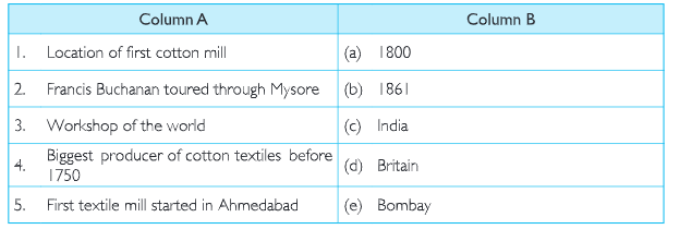
Answer. 1. (e) 2. (a) 3. (d) 4.(c) 5. (b)
KSEEB Class 8 History Chapter 7 Important Questions
Weavers, Iron Smelters, and Factory Owners C. Picture Interpretation
Look at the given picture and answer the following questions: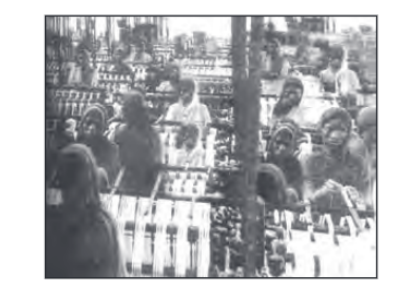
- What work is being done in the given picture?
- How was the work of weaving done?
Answer.
- The work of weaving is being done in the given picture as women are working in the spinning department.
- Women weavers usually did the work o–‘ spinning. The chakha and the to Of were household spinning instruments. The thread was spun on the charkha and rolled on the took When the spinning was over, the thread was woven into cloth by the weaver.
Weavers, Iron Smelters and Factory Owners D. Map Skills
On an outline map of India, locate and mark the chief weaving centers in the eighteenth century
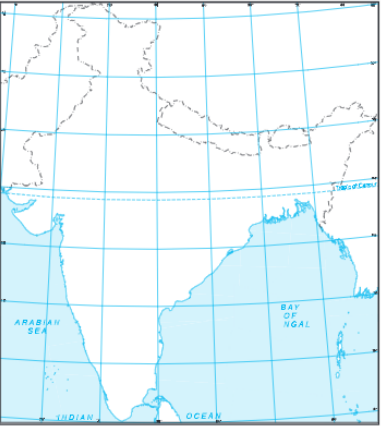
Answer
